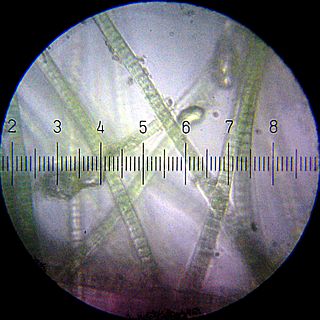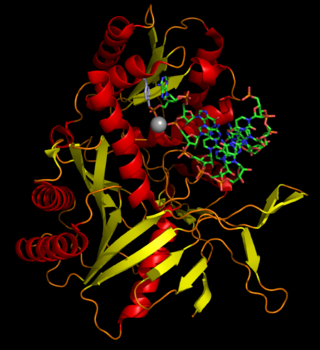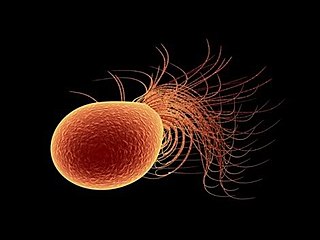Primary nutritional groups are groups of organisms, divided in relation to the nutrition mode according to the sources of energy and carbon, needed for living, growth and reproduction. The sources of energy can be light or chemical compounds; the sources of carbon can be of organic or inorganic origin.

A heterotroph is an organism that cannot produce its own food, instead taking nutrition from other sources of organic carbon, mainly plant or animal matter. In the food chain, heterotrophs are primary, secondary and tertiary consumers, but not producers. Living organisms that are heterotrophic include all animals and fungi, some bacteria and protists, and many parasitic plants. The term heterotroph arose in microbiology in 1946 as part of a classification of microorganisms based on their type of nutrition. The term is now used in many fields, such as ecology, in describing the food chain.
Methanogens are microorganisms that produce methane as a metabolic byproduct in hypoxic conditions. They belong to the domain Archaea and are members of the phylum Euryarchaeota. Methanogens are common in wetlands, where they are responsible for marsh gas, and can occur in the digestive tracts of animals including ruminants and humans, where they are responsible for the methane content of belching and flatulence. In marine sediments, the biological production of methane, termed methanogenesis, is generally confined to where sulfates are depleted below the top layers and methanogens play an indispensable role in anaerobic wastewater treatments. Other methanogens are extremophiles, found in environments such as hot springs and submarine hydrothermal vents as well as in the "solid" rock of Earth's crust, kilometers below the surface in the deep biosphere.

Biological carbon fixation or сarbon assimilation is the process by which inorganic carbon is converted to organic compounds by living organisms. The compounds are then used to store energy and as structure for other biomolecules. Carbon is primarily fixed through photosynthesis, but some organisms use a process called chemosynthesis in the absence of sunlight.

Archaeoglobaceae are a family of the Archaeoglobales. All known genera within the Archaeoglobaceae are hyperthermophilic and can be found near undersea hydrothermal vents. Archaeoglobaceae are the only family in the order Archaeoglobales, which is the only order in the class Archaeoglobi.
Archaeoglobus is a genus of the phylum Euryarchaeota. Archaeoglobus can be found in high-temperature oil fields where they may contribute to oil field souring.
Methylotrophs are a diverse group of microorganisms that can use reduced one-carbon compounds, such as methanol or methane, as the carbon source for their growth; and multi-carbon compounds that contain no carbon-carbon bonds, such as dimethyl ether and dimethylamine. This group of microorganisms also includes those capable of assimilating reduced one-carbon compounds by way of carbon dioxide using the ribulose bisphosphate pathway. These organisms should not be confused with methanogens which on the contrary produce methane as a by-product from various one-carbon compounds such as carbon dioxide. Some methylotrophs can degrade the greenhouse gas methane, and in this case they are called methanotrophs. The abundance, purity, and low price of methanol compared to commonly used sugars make methylotrophs competent organisms for production of amino acids, vitamins, recombinant proteins, single-cell proteins, co-enzymes and cytochromes.

Pyrococcus furiosus is a heterotrophic, strictly anaerobic, extremophilic, model species of archaea. It is classified as a hyperthermophile because it thrives best under extremely high temperatures, and is notable for having an optimum growth temperature of 100 °C. P. furiosus belongs to the Pyrococcus genus, most commonly found in extreme environmental conditions of hydrothermal vents. It is one of the few prokaryotic organisms that has enzymes containing tungsten, an element rarely found in biological molecules.

The Wood–Ljungdahl pathway is a set of biochemical reactions used by some bacteria. It is also known as the reductive acetyl-coenzyme A (Acetyl-CoA) pathway. This pathway enables these organisms to use hydrogen as an electron donor, and carbon dioxide as an electron acceptor and as a building block for biosynthesis.
In enzymology, carbon monoxide dehydrogenase (CODH) (EC 1.2.7.4) is an enzyme that catalyzes the chemical reaction
In enzymology, a carbon-monoxide dehydrogenase (ferredoxin) (EC 1.2.7.4) is an enzyme that catalyzes the chemical reaction

An autotroph is an organism that produces complex organic compounds using carbon from simple substances such as carbon dioxide, generally using energy from light (photosynthesis) or inorganic chemical reactions (chemosynthesis). They convert an abiotic source of energy into energy stored in organic compounds, which can be used by other organisms. Autotrophs do not need a living source of carbon or energy and are the producers in a food chain, such as plants on land or algae in water. Autotrophs can reduce carbon dioxide to make organic compounds for biosynthesis and as stored chemical fuel. Most autotrophs use water as the reducing agent, but some can use other hydrogen compounds such as hydrogen sulfide.

Mariprofundus ferrooxydans is a neutrophilic, chemolithotrophic, Gram-negative bacterium which can grow by oxidising ferrous to ferric iron. It is one of the few members of the class Zetaproteobacteria in the phylum Pseudomonadota. It is typically found in iron-rich deep sea environments, particularly at hydrothermal vents. M. ferrooxydans characteristically produces stalks of solid iron oxyhydroxides that form into iron mats. Genes that have been proposed to catalyze Fe(II) oxidation in M. ferrooxydans are similar to those involved in known metal redox pathways, and thus it serves as a good candidate for a model iron oxidizing organism.
Pyrobaculum aerophilum is a single-celled microorganism in the genus Pyrobaculum. The first Pyrobaculum species to be sequenced was P. aerophilum. It is a rod-shaped hyperthermophilic archaeum first isolated from a boiling marine water hole at Maronti Beach, Ischia. It forms characteristic terminal spherical bodies like Thermoproteus and Pyrobaculum. Its type strain is IM2; DSM 7523). Its optimum temperature for growth is around boiling point for water. Its optimum pH for growth is 7.0. Sulfur was found to inhibit its growth.
Thermotoga neapolitana is a hyperthermophilic organism that is a member of the order Thermotogales.
Methanothermus sociabilis is a species of methanogen. It grows in large clusters 1 to 3 mm in diameter and in temperatures of up to 97 °C (207 °F). It is found solely in the solfataric fields in Iceland. The cells are bar-shaped and grow strictly through the reduction of carbon dioxide with hydrogen, producing methane.
Sulfolobus metallicus is a coccoid shaped thermophilic archaeon. It is a strict chemolithoautotroph gaining energy by oxidation of sulphur and sulphidic ores into sulfuric acid. Its type strain is Kra 23. It has many uses that take advantage of its ability to grow on metal media under acidic and hot environments.
Thermococcus profundus is a hyperthermophilic archaeon isolated from a deep-sea hydrothermal vent. It is coccoid-shaped with 1–2 μm in diameter, designated as strain DT5432.
Thermococcus alcaliphilus is a hyperthermophilic archaeon. It is coccoid-shaped and heterotrophic, first isolated from a shallow marine hydrothermal system at Vulcano Island, Italy. Its type strain is AEDII12.
Thermosinus carboxydivorans is an anaerobic, thermophilic, Gram-negative, carbon-monoxide-oxidizing, hydrogenogenic bacterium, the type species of its genus. It is facultatively carboxydotrophic, curved, motile, rod-shaped, with a length of 2.6–3 μm, a width of about 0.5 μm and lateral flagellation. Its type strain is Nor1T.





